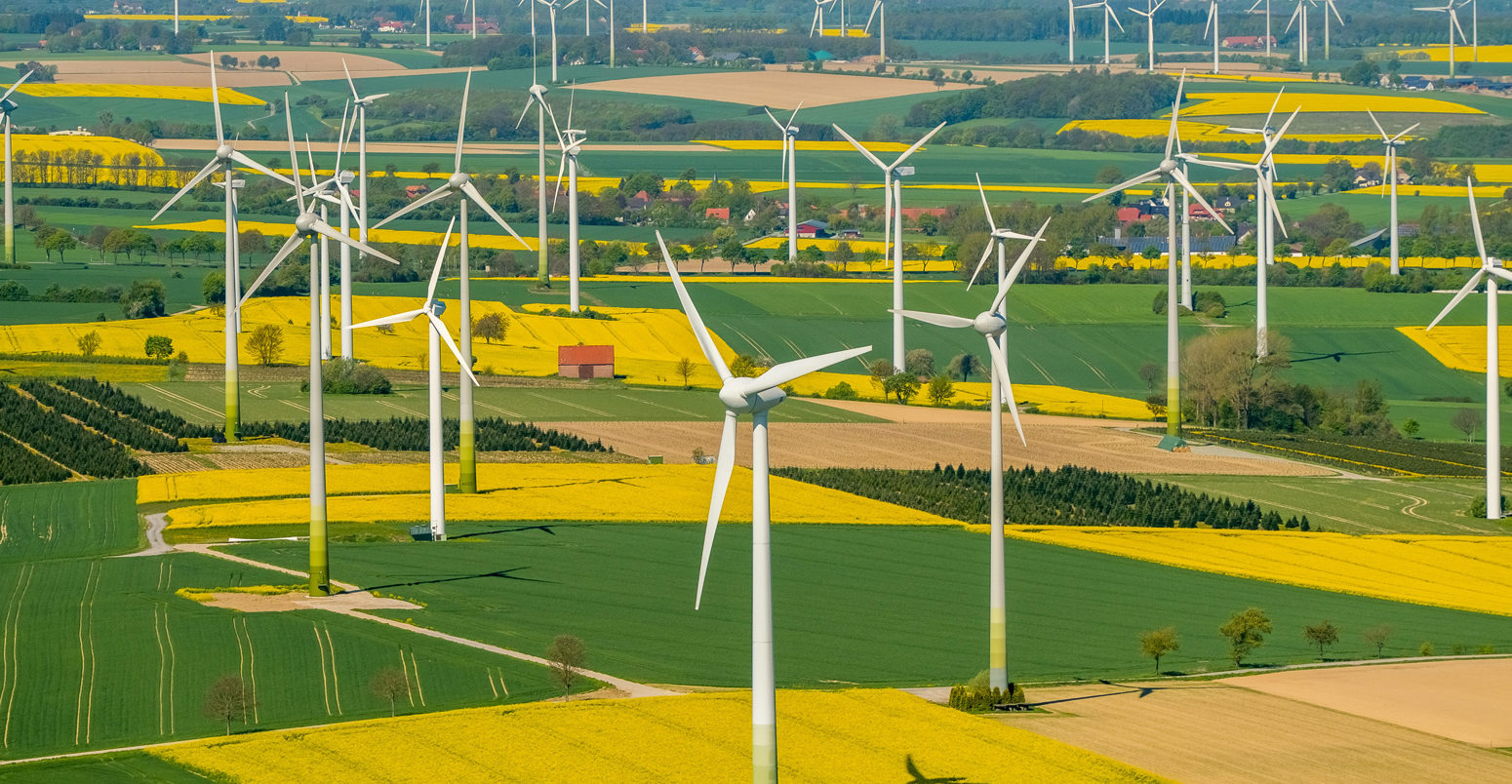
UNEP: Net-zero pledges provide an ‘opening’ to close growing emissions ‘gap’
Zeke Hausfather
12.09.20Zeke Hausfather
09.12.2020 | 10:00amThe recent net-zero pledges by major emitting countries and the potential for a “green recovery” from the Covid-19 pandemic “presents the opening” for the world to close the growing “gap” between existing commitments and what is needed to limit global warming to meet the Paris Agreement goals.
This is according to the latest UN Environment Programme (UNEP) emissions gap report, published today.
The annual report, now in its 11th year, finds that global emissions will fall in 2020 due to Covid-19 related disruptions. But it also shows starkly how quickly the 1.5C goal is slipping out of reach, as well as how limiting global warming to the “well below” 2C goal is becoming more difficult with every passing year in which emissions continue to grow.
However, UNEP highlights three areas – the recovery from Covid-19, a new willingness by countries to set ambitious mitigation targets, and the rapid advances in clean energy technologies – which together provide an opportunity to help close this “emissions gap”.
But, in the absence of more structural policy-driven changes, it suggests that emissions will rebound in coming years and the gap between commitments and necessary levels of mitigation will remain as large as it was last year. (Carbon Brief’s archives also include detailed coverage of the UNEP reports in 2014, 2015, 2016, 2017, 2018 and 2019).
This year’s report finds that, by 2030, global greenhouse gas emissions will need to fall by 23% from 2019 levels to put the world on track to “likely” (66% chance) avoid 2C warming above pre-industrial temperatures, by 33% to likely avoid 1.8C warming, and by 56% to likely avoid 1.5C warming.
The existing short-term commitments under the Paris Agreement, on the other hand, imply that emissions will simply plateau, remaining only slightly below 2019 levels by 2030.
At the same time, a growing number of countries – including China, Japan, South Korea, the EU, the UK and the incoming Biden-Harris administration in the US – have recently pledged to bring emissions down to net-zero by the year 2050 or 2060.
The report suggests that these commitments are “broadly consistent” with the Paris Agreement’s 1.5C goal, but still need to be reflected in near-term policy action and via enhanced “nationally determined contributions” (NDCs).
Emissions trajectory
Each UNEP report analyses the previous year’s emissions. However, this year’s report also includes some analysis of 2020’s projected emissions thanks to the extra work already undertaken by a variety of researchers around the world keen to study the impact of Covid-19 lockdowns.
The new report shows that global greenhouse gas (GHG) emissions rose in 2019, mostly due to CO2 emissions from land-use and non-CO2 GHGs. Emissions of CO2 from fossil fuels remained at roughy 2018 levels, though increases in China were offset by decreases in the rest of the world.
The figure below, from the new UNEP report, shows both the absolute and per-capita emissions from major emitting nations. It also shows the emissions from international transport – aviation and shipping – which are often excluded from domestic emission accounts and are a special focus of this year’s report.
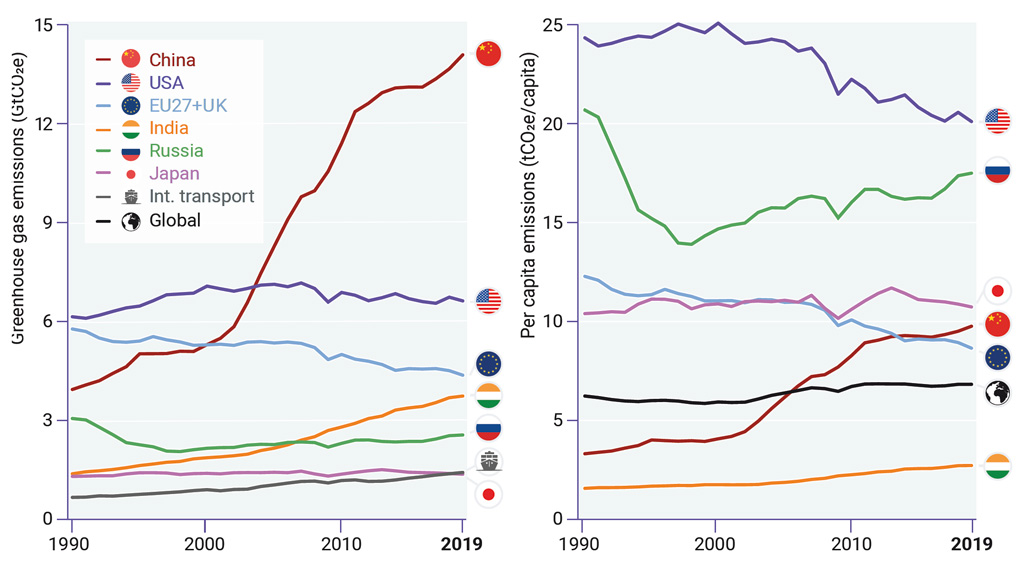
The magnitude of international transport emissions is particularly noteworthy – it would be the 6th largest emitter of GHGs, if it were a country. The sector currently accounts for around 5% of global emissions and is expected to grow rapidly in the future as greater levels of prosperity in developing countries increases demand for travel and goods.
Emissions from international transport are generally not covered by existing Paris Agreement climate pledges, known as “nationally determined contributions” (NDCs). The report suggests that efficiency alone will be insufficient to decarbonise the sectors and that alternatives, such as biofuels, synfuels, hydrogen and electrification, are needed.
Looking at this year’s trends overall, the UNEP report says that the Covid-19 pandemic is expected to cause emissions to fall in 2020, with CO2 emissions likely to decline around 7% relative to 2019 levels.
The UNEP report suggests that the fall in total GHG emissions will likely be a bit smaller, as they are less affected by pandemic-related disruptions. If non-CO2 emissions remain at 2019 levels, overall GHG emissions would be expected to decline around 5% – or around 3 GtCO2e – in 2020, it says. The report suggests that some of this reduction will linger due to slower economic growth and accelerated capital replacement, with a 2-4GtCO2e reduction persisting through to 2030 relative to pre-Covid projections.
The figure below, adapted from the report, shows UNEP’s latest emissions gap analysis at a glance. Emission trajectories associated with policies that were in place in 2010 – but nothing after that point – are shown in red and current policies already implemented by governments in orange.
Additional commitments in NDCs that are not yet implemented are shown in yellow for unconditional commitments and light blue for those conditional on aid or action by other countries. Emission trajectories consistent with staying below 2C, 1.8C and avoiding 1.5C are shown in blue, purple and grey, respectively.
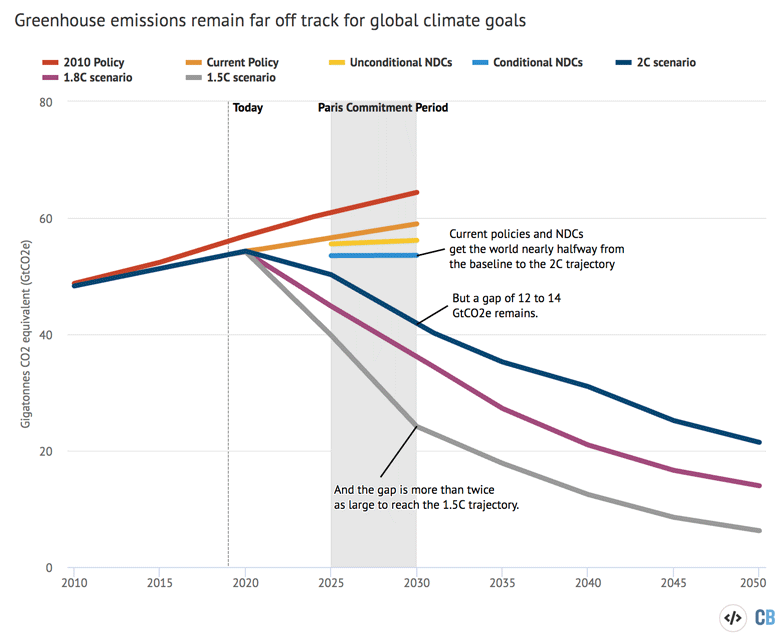
There is a large gap between what countries have committed to, in terms of future emission reductions, and what would be needed to meet the Paris Agreement goals. Current NDCs would result in global emissions plateauing rather than declining. They would leave the world in 2030 some 12-15bn tonnes of CO2 equivalent (GtCO2e) short of what is needed to be on track to limit warming below 2C and 29-32GtCO2e short for 1.5C.
Net-zero goals
At the same time, the report notes that an increasing number of countries have set net-zero emission targets, with a number of major emitters announcing 2050 or 2060 targets over the course of 2020.
Currently 126 countries covering 51% of global GHG emissions have net-zero goals that are either formally adopted, announced, or under consideration. With the incoming Biden-Harris administration in the US, this will increase to 63%. These countries include major emitters, such as the UK, EU, China, Japan, Korea, Canada, South Africa, Argentina and Mexico. This is also notably up from the 65 countries that had similar commitments at this point in 2019.
However, there is a large difference between announced long-term climate targets and the short-to-medium term actions needed to accomplish them, stresses the new report. Some targets – such as those proposed by the incoming Biden administration – will still need to be translated into more binding legislation, which may prove challenging. The UNEP report suggests that countries need to submit new and updated NDCs consistent with the net-zero emissions goals.
The report also suggests that meeting existing NDCs would put the world on track for a 66% chance of avoiding 3.2C warming above pre-industrial levels by 2100, consistent with other recent assessments of current and stated policy scenarios. They suggest that the full implementation of current net-zero commitments would lead to avoiding (with a 66% chance) warming of 2.7C without the US and 2.5C with the US.
These numbers are consistent with the recent Climate Action Tracker (CAT) report (see its graphic below), which suggests that a full implementation of current net-zero commitments would result in a 50% chance of limiting warming to 2.1C. CAT uses different thresholds, but a 50% chance of limiting warming to 2.1C is comparable to a 66% chance of limiting warming to 2.5C given the uncertainties in climate sensitivity, though these different ways of expressing global warming outcomes can be quite confusing. Estimating the effects of these net-zero targets on global temperatures is challenging, in part because it relies on assumptions around emissions in those countries currently lacking net-zero commitments.
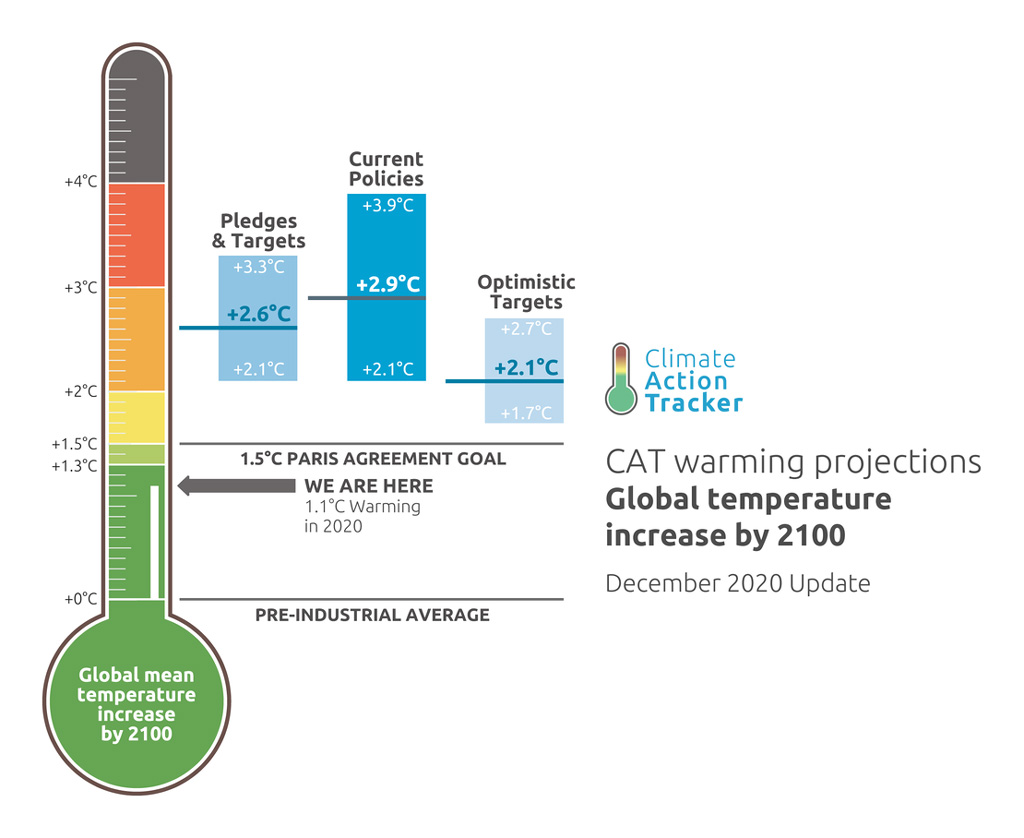
Currently many countries are not on track to meet their NDC commitments. Only nine G20 members are on track to meet their 2030 commitments, five members are on track to miss their targets and, for two, the outcome is unclear. While the net-zero commitments made by many countries are a hopeful sign, the new UNEP report shows that until they are reflected in actual short-to-medium-term policy there is a risk they may turn out to be empty promises.
Time is running out
There is relatively little carbon budget remaining for global warming to be limited to 1.5C above pre-industrial levels. The report highlights how, if 2020 emissions expected to be around 7% lower than those in 2019, there will be only around 295GtCO2 – or seven years of current emissions – remaining that can be emitted before the world wants to have a 66% chance of avoiding 1.5C warming. For a 50% chance of avoiding 1.5C, the remaining carbon budget is only around 455GtCO2, or around 10 years of current emissions.
While this carbon budget could be expanded through the widespread use of negative emissions technologies (NETs) later in the century – as is assumed in the 1.5C scenarios used by the UNEP report – there is some reluctance to bet the future on NETs that are still largely unproven at scale.
Carbon Brief’s interactive chart below, inspired by the UNEP gap report analysis and adapted from one created by CICERO’s Dr Robbie Andrews, shows emission trajectories to limit global warming to below 1.5C in the absence of net-negative emissions. The different lines show the emissions reductions that would be required if emissions had peaked in each year, between 2000 and 2026, with the current year (2020) highlighted in grey.
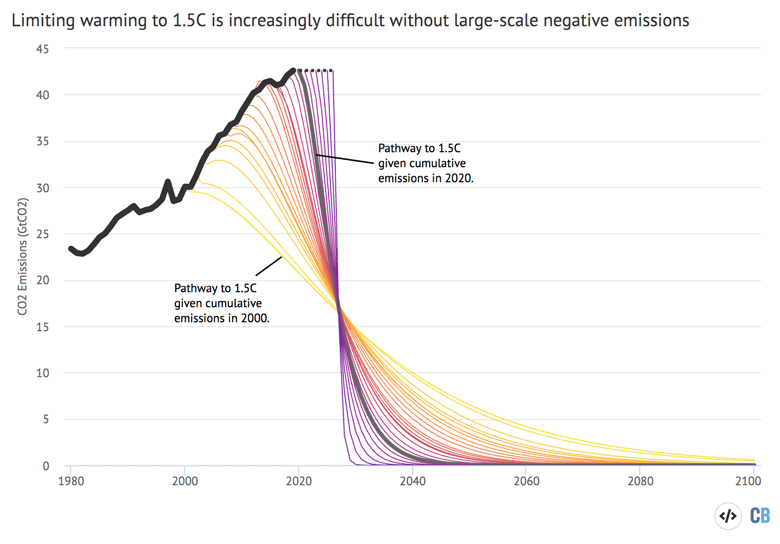
If emissions had peaked and begun to decline after 2000, the 1.5C target would have been much easier to achieve, only requiring reductions of around 3% per year. By contrast, limiting warming to below 1.5C starting in 2020, without the use of NETs, would require a roughly 14% cut each year through to 2040.
With the inclusion of NETs, it is possible to create scenarios to limit warming below 1.5C that do not involve quite so precipitous a drop in emissions in the coming years. However, these rely on planetary scale deployment of NETs – with some models needing three times the land area of India for deploying bioenergy with carbon capture and storage (BECCS) in order to “suck” roughly half of the world’s current human-caused emissions from the atmosphere each year.
Each year that passes without global emission reductions puts the 1.5C target further out of reach, says the UNEP report. While the Paris Agreement’s “well below” 2C target is easier to achieve than 1.5C, delays will make it increasingly difficult, too.
Carbon Brief’s interactive chart below shows the emission reductions needed, by peaking year, to meet the 2C target without use of net-negative emissions.
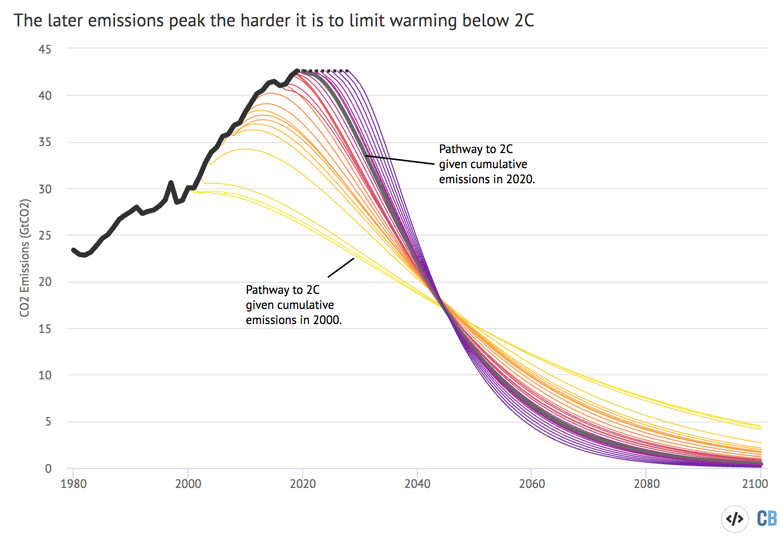
Overall, the latest UNEP gap report suggests that the world has “stronger pledges on climate” in recent years and that even current policies have moved the world away from some of the worst-case emissions scenarios.
At the same time, the gap between what is actually occurring and what is needed to limit warming to Paris Agreement targets of 1.5C and 2C continues to grow larger with each passing year, necessitating ever steeper future reductions. While the recent net-zero commitments by a number of major emitting nations are “significant and encouraging”, the proof will be in “the extent to which they are reflected in near-term policy action”.
-
UNEP: Net-zero pledges provide an ‘opening’ to close growing emissions ‘gap’
-
UNEP: Three things that offer an ‘opening’ to close growing emissions ‘gap’

